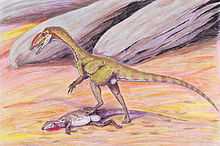Scutellosaurus
| Scutellosaurus Temporal range: Early Jurassic, 196Ma | |
|---|---|
 | |
| Scutellosaurus lawleri | |
| Scientific classification | |
| Kingdom: | Animalia |
| Phylum: | Chordata |
| Clade: | Dinosauria |
| Order: | †Ornithischia |
| Clade: | †Thyreophora |
| Genus: | †Scutellosaurus Colbert, 1981 |
| Species: | † S. lawleri |
| Binomial name | |
| Scutellosaurus lawleri Colbert, 1981 | |
Scutellosaurus (pron.:"skoo-TELL-oh-SORE-us") is an extinct genus of thyreophoran ornithischian dinosaur that lived approximately 196 million years ago during the early part of the Jurassic Period in what is now Arizona. It is classified in Thyreophora, the armoured dinosaurs; its closest relatives may have been Emausaurus and Scelidosaurus, another armored dinosaur which was mainly a quadrupedal dinosaur, unlike bipedal Scutellosaurus. It is one of the earliest representatives of the armored dinosaurs and the basalmost form discovered to date.[1] Scutellosaurus was a small, lighly-built, ground-dwelling, herbivore, that could grow up to an estimated 1.175 m (3.9 ft) long.
Etymology

The genus name Scutellosaurus, means "little-shielded lizard", and is derived from the Latin word "scutelum" meaning "little shield", and the Greek word "sauros" (σαύρα) meaning "lizard".[2] The type and only valid species known today is Scutellosaurus lawleri. The specific name honors David Lawler who collected the fossil.
Description
Scutellosaurus was lightly built, and was probably capable of walking on its hind legs. It had an unusually long tail, possibly to provide a counterbalance against the weight of the armored body, and long arms that suggest it may have browsed on all fours.[3] It was around 1.2 metres (3.9 ft) long,[3] 50 centimetres (20 in) tall at the hips, and weighed 10 kilograms (22 lb). The fossil evidence includes two partial skeletons recovered from Arizona, although of the skull only the lower jaw has been recovered. There were also several hundred scutes running along its neck to its back and as far down as its tail. These formed parallel rows, with as many as five rows on each side. It also had double rows of scutes, or external plates, running neck to tail.[1] Some of these shields were flat, while others were pitted.
Discovery and occurrence

The type specimen of Scutellosaurus lawleri MNA V 175 was recovered at the West Moenkopi Plateau locality in the Silty Facies Member of the Kayenta Formation, in Coconino County, Arizona. The specimen was collected by David Lawler, in red claystone sediments that were deposited during the Sinemurian stage of the Jurassic period, approximately 196 million years ago.

The holotype specimen was described by Edwin Colbert based on the following: partially preserved premaxillae with teeth, a right maxilla with seven teeth, a maxillary fragment, a left maxilla with five teeth, dentaries that are missing their posterior portions, a left dentary with 18 teeth, a right dentary with 10 teeth, other skull fragments, 21 presacral vertebral centra, several complete and partial neural arches and spines, five sacral vertebrae, 58 caudal vertebrae with neural arches and several chevrons, several incomplete ribs, both scapulae, both coracoids, partially preserved ilia, fragments of the pubic bones and of the ischia, both humeri, the distal end of the right radius, the proximal and distal ends of the left radius and ulna, fragments of the manus, both femora, the right tibia, the proximal end of the right fibula, the right astragalus, the left tibia, the left fibula, various bones of the pedes, including a possible distal tarsal bone, and over 300 osteoderms.
References
- ↑ 1.0 1.1 Benton, Michael J. (2012). Prehistoric Life. Edinburgh, Scotland: Dorling Kindersley. p. 271. ISBN 978-0-7566-9910-9.
- ↑ Liddell, Henry George and Robert Scott (1980). A Greek-English Lexicon (Abridged Edition). United Kingdom: Oxford University Press. ISBN 0-19-910207-4.
- ↑ 3.0 3.1 Palmer, D., ed. (1999). The Marshall Illustrated Encyclopedia of Dinosaurs and Prehistoric Animals. London: Marshall Editions. pp. 134–135. ISBN 1-84028-152-9.
- The Illustrated Dinosaur Encyclopedia, D. Dixon, 1998 (ISBN 0-7064-3238-X)